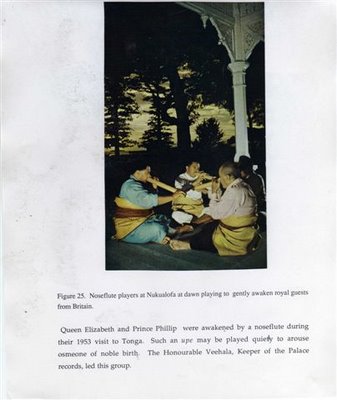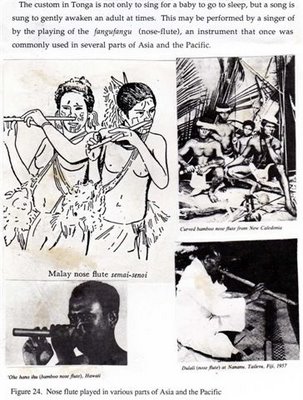When I was researching Fijian music I could never find even one person who played the nose-flute in Fiji though Chris Saumaiwai did. Now there's an article about one man who plays it. It is more commonly played in Tonga, though even there it is uncommon.
In the village of Nananu on the coast in the north of Tailevu, about one and a half hours drive from Suva, lives a man who has a special gift for playing the nose flute.
Kaveni Tamani of the Nabati clan is the only person who has kept alive the skill which dates back to the legendary days of an ancestral god.
The indigenous Fijian musical instrument called the nose flute is known in the iTaukei language as dulali or bitu ceguvi.
This form of music has disappeared altogether from Fiji except for Nananu. Nananu is made up of three clans — Korolevu, Sawatini and Nabati.
According to village records, Nananu had a different setup in the old days. Each clan dwelt on its hill fort during the tribal warring days before Christianity.
Kaveni's story has since been recorded by the iTaukei Institute of Language & Culture under the Ministry of iTaukei Affairs. Acting prinicipal administrative officer, Simione Sevudredre said this was made possible after a funding under UNESCO's Intangible Cultural Heritage Centre for the Asia Pacific (ICHCAP) in 2011 was provided.
The award was secured after two officers from the ministry, Kelera Adikakua and Mereoni Dikula, underwent training on Intangible Cultural Heritage documentary in Korea, and at the same time satisfied funding criteria for participants who wished make a documentary as part of their practical work back in their own country.
The funding was also in recognition of the institute's active role in safeguarding, and promoting iTaukei traditional knowledge and expressions of culture.
Mr Sevudredre said with the production of such documentaries, they hoped to revitalise and promote iTaukei culture.
"We'd also like readers to know that the documentaries can be viewed and downloaded on the youtube section of our website www.itaukeiaffairs.gov.fj," he said.
Back to Kaveni.
The gift of playing the nose flute was practised by Kaveni's father, Laisiasa Tauba but where he received the gift from or where he learnt it is lost to the mists of time as Kaveni liked to say.
When visited at his village, Kaveni was busy cutting bamboos on the shore. He said he wanted to make a bamboo raft so his family members could use it for fishing.
For a 78-year-old, he looked quite fit and had the gait of much younger man.
How it began
Jovial in nature and a bit of a ladies man, the nose flutist was quite open to sharing his story which was incidently passed down to him by accident, or so he says.
"I have been playing this instrument since my father passed away. None of us his children ever thought of learning it while he was still alive. When he died, I went to my parent's house and brought the bamboo flute home and kept it with me," he said as he stroked the bamboo which had light carvings on it.
To learn playing the nose flute surprisingly had never dawned on Kaveni. Growing up, he said, he only helped carve the bamboo head rest on which his father would lie on to play the flute.
"My father would play early in the morning from where he lay close to the hearth," he told this newspaper.
"In fact I only learnt how to play after a visit by the then Tailevu provincial administrator in 1973, Ratu Kitione Vesikula . He had wanted my father to go with a Fiji delegation overseas to perform overseas.
"We were gathered at the village headman's house and the provincial administrator asked: "Kaveni have you ever played this flute before your father died?
"I said 'not once ever sir'."
The PA said: "Alas, how shall this be done then?
"He then implored me to start learning it and if I was succesful, I would be be part of the country's delegation."
Kaveni said he started playing the flute like his breath depended on it.
"My upper lips had bruises as a result of pracitising every day," said the Nananu villager.
"To play the nose flute, I have only a cup of tea in the morning and I don't eat anything three hours before performing so I can sustain my breathing. It's a challenging art to learn."
Challenging yet rewarding. The traditional art has since brought Kaveni, regional and international recognition and accolades for his traditional performance.
In 1973, he was invited to perform at the opening of the Sydney Opera House. He was only 34 years old. He also performed at the 2006 Melanesian Arts Festival in Suva.
"I was sitting just across from Queen Elizabeth II who was a guest at the opening!" he said proudly.
"I have been asked whether the flute has aspects of charm to it, or whether I practise black magic but it's ridiculous to hear such sentiments from some people," Kaveni said with a touch of indignation.
Legends of old
While it's not known where the art of nose flute began or how Kaveni's father acquired the skill, traditional knowledge points to Fiji's pre-history era, to the time of Ramacake, Fiji's equivalent to Pan in Greek mythology (Pan was the god of the wild, shepherds and flocks, nature of mountain wilds and rustic music and is often associated with sexuality).
According to the head of the yavusa or clan of Sawatini — Filimoni Donu — in a documentary produced by the Ministry of iTaukei Affairs; Ramacake, a shape shifter hailed from Nanukuloa in Ra Province and was adept on the pan flute. The flute's melodious strains was an irresistible charm to maidens. However the elders were not amused and so they banished him.
"Ramacake left his home for Lovoni on another island and it was here the pan flute temporarily stayed. From Lovoni he then relocated to an island called Makodraga jutting out from Makogai. It was here he dwelt and played his pan flute," said Mr Donu in the iTaukei language.
"The lilting notes of the pipes had a bewitching effect on young maidens who were drawn to the seas around Makogai in the hope of finding a handsome prince, only to turn away upon meeting Ramacake who often disguised himself in the form of a leper."
According to the legend, Ramacake's flute roused and lulled the Ratu mai Verata every day.
The ancient Verata kingdom once spanned most of the northern Tailevu Province including islands such as Qoma, Naigani, Ovalau, Wakaya and Makogai, he said.
Ramacake would play his flute every morning and the echoes would go across the sea right to the Ratu mai Verata. Choreographers and maidens came from all over Fiji in search of the famed flutist but to no avail because Ramacake would spy their approaching canoes and direct the echo to another island. He would make the sound emanate from Koro Island, Wakaya or Ovalau.
This was why Makogai Island was always bypassed.
Myth or fact
Some legends may seem incredible to believe due to its fictious elements, however there is some underlying truth to it.
According to the Ministry of iTaukei Affairs, which has recorded oral traditions from villages around the country, how the art moved from Lovoni to Nananu points to an ancient link between the people of the two tribes.
Ancient traditions tell of Rakavono, ancestral founder of the Lovoni tribe, having once dwelt at Nananu before settling at Lovoni.
"It may be perplexing to realise that the art was introduced to this village. If some people may doubt this gift and how it was introduced to this village, we must not be surprised," said Pio Manoa an iTaukei Fijian literature and culturalist in the documentary.
"Legends for that reason embed multi-layered analysis.
"One such analysis is to do with relationship. Legends have a significant role in our existence. There are numerous legends and they are human heritage. Not only legends, but dances, chants, poems, lullabies and the like.
"If we closely examine these genres, at one level they may be fictious or not entirely factual but they underpin truths between relationship or factual historical events.
"There is an element of truth that is mirrored as to how people are related etc. It is in this respect certain truths are coded in legends."
As to how it specifically came to the Nabati clan, some say the reason is because of their totem tree being the bamboo called bitu cebailagi as can be seen growing on their ancient village site, Korosomo
According to Kaveni, the bamboo grows atop of the hill fort belonging to the Nabati clan where their totem bamboo grows and was once the fame and pride of the Nabati clan in Nananu.
Keeping the tradition alive
For now Kaveni ekes out a simple living. Now and then he said a tourism company in Pacific Harbour engaged him for various cultural performances there. He makes about $40 for performing on a given day.
His other roles in the village involve tasks for the church, and traditional obligations. He also tends to his small farm for his subsistent existance. He has three daughters. As a sibling he has only one brother and three sisters.
"I want only my grandson to learn this craft," he said with a sense of possesiveness. "He has shown keeness in learning it and I hope when I pass on, he would pass it on. This skill must never die in Fiji.
"Ratu Vesikula (Tailevu provincial administrator) told me back in 1973 to look after my health and to learn the art, and one day it would serve me well and bring good fortune.
"It has served me well these past 40 years." He said with finality.






















 + Enlarge this image
+ Enlarge this image






5 comments:
see 1. http://www.accu.or.jp/ich/pdf/c2005subreg_RP2.pdf#search=%22Fiji%20cultural%20mapping%22
and
http://www.fijianaffairs.gov.fj/Culture%20&%20Heritage/dbarts1.htm
About the nose flute - I have never seen one in Fiji, but Chris Saumaiwai wrote something about it one time.
My MA thesis about the music of Labasa in in the Pacific Collection at USP - but as an 'outsider' I'm still a stranger to much of the cultural information.
W.
Its early days on the cultural inventory project - I doubt there's any ethnomusicolo.. whatumacallits involved as the dept is very small and under-resourced. So far, the focus of the mapping is traditional mats which are specialised by different women in different provinces, not so much music and traditional instruments. Hopefully the old men who do play the nose flute in the hills are passing on the tradition to younger people and will not be dead by the time the mapping project gets to them!
Theres a few bands from Macuata doing well on the local scene - the harmonies are nice and the dialect is practically another language!